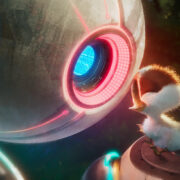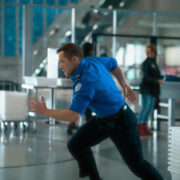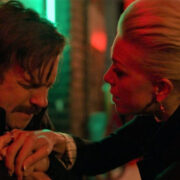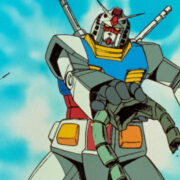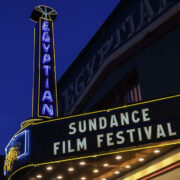The Beginner’s Guide: John Hughes, Director
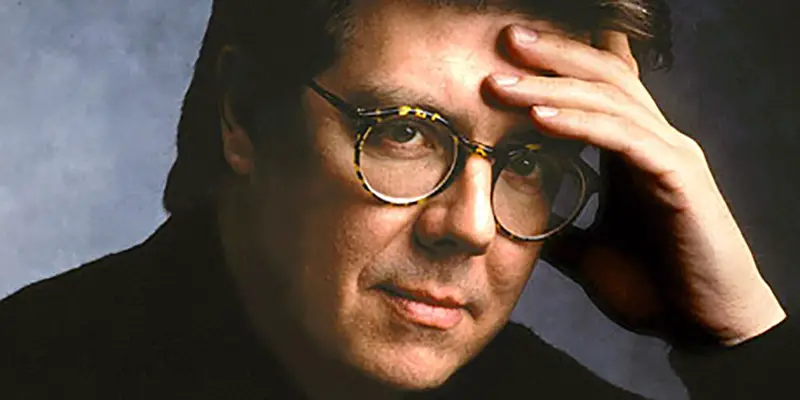
Lauren is 20 years old and is a Multimedia Journalism…
Accurately reflecting teenage experience in film is no mean feat, and there aren’t many filmmakers to achieve it like John Hughes. Born in Michigan in 1950, Hughes described himself as a “quiet kid” who loved The Beatles. Aged 12, he and his family moved to the Chicago suburb Northbrook in Illinois. Navigating adolescence on the outskirts of a wealthy neighbourhood, Hughes’ experiences at Glenbrook High School would inspire his work as a filmmaker.
Graduating High School in 1968, Hughes attended the University of Arizona, dropping out in his junior year. He returned to Chicago to pursue a career as a copywriter throughout the 1970s, also selling jokes and writing what became National Lampoon’s Vacation, which kickstarted his filmmaking career in 1983.
Referred to by Roger Ebert as “the philosopher of adolescence”, Hughes’ work – which included eight directorial efforts and numerous screenplay credits – has influenced numerous directors, including Wes Anderson and Judd Apatow, and he endures as one of the most beloved filmmakers of the 1980s.
The Breakfast Club (1985)

Hughes made his directorial debut in 1984 with Sixteen Candles, but it was The Breakfast Club that established him as a tour de force in the burgeoning teen film genre. Considered by many to be the best high school film ever made, the quintessentially ’80s film brought together the “brat pack” of rising stars, including Sixteen Candles’ Molly Ringwald and Anthony Michael Hall, alongside Ally Sheedy, Emilio Estevez and Judd Nelson.
Hughes wrote and directed the film, which was a story of five teenagers, each of whom embodies a high school stereotype, who are forced to spend the day together for Saturday detention. Filmed on a modest budget in a single location, The Breakfast Club is a success due to Hughes’ uncanny ability to write realistically for teenagers. In interviews, Hughes’ early muse Molly Ringwald noted his talent for bringing young casts together and writing dialogue that felt believable to them. For The Breakfast Club, the cast rehearsed for three weeks before the film was shot in sequence, enhancing the nostalgic realism.
In a world where Hughes’ work is the benchmark of the teen genre, it’s easy to forget how groundbreaking it was. Teen films of the early ’80s were risqué – think Porky’s and Fast Times at Ridgemont High – but Hughes spearheaded another direction, focusing on the awkwardness of adolescence. Few films have so well encapsulated the plight of middle class American teenagers, but the distinct lack of diversity also cannot be ignored – Ringwald has since said she finds it “embarrassing” that The Breakfast Club, as with most of Hughes’ filmography, is totally white – a shame considering the relatable themes could only have benefited from diversification.
Everything about the film is shown from the teenage viewpoint. Contemporary music, including now legendary Simple Minds track Don’t You (Forget About Me), and believable characters make the film relatable, like raunchier teen comedies never could be. Assistant Principle Dick Vernon (Paul Gleeson), one of the only authority figures, is totally ignorant to the fact that the characters are so much more than the various stereotypes they may embody, acting as a metaphor for how many young people feel about authority figures in and beyond the American education system.
The ideas explored here – yearning to be noticed, internal and external pressures, social constructs – became commonplace in much of Hughes’ work, but he never did it better than with the oft-parodied yet enduringly likeable exploits of The Breakfast Club.
Ferris Bueller’s Day Off (1986)
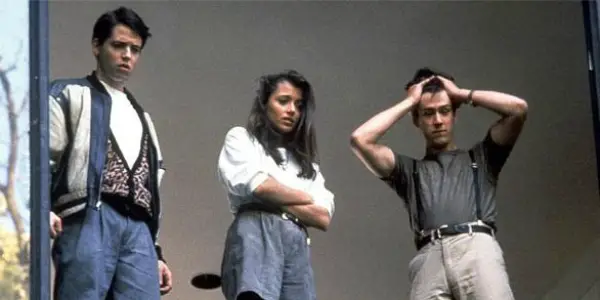
Often considered his magnum opus, Ferris Bueller’s Day Off is Hughes’ ultimate feel-good film. Shot back-to-back with The Breakfast Club to minimise cost, it is Hughes’ love letter to Chicago, moving the action outside school hallways and into the city he loved.
The film tells the story of Ferris Bueller (Matthew Broderick), a high school senior who fakes being sick in order to skip school and embark on a day of adventures with his girlfriend Sloane (Mia Sara) and best friend Cameron (Alan Ruck).
As is the case across Hughes’ filmography, it is a simple premise that thrives on insightful writing. The film explores unbridled hedonism through Ferris, but it is Cameron who keeps things grounded, making him an infinitely more interesting and relatable character. The Ferris/Cameron juxtaposition is a visual manifestation of how many teenagers feel – who we wish we could be versus who we really are – and through the seemingly carefree narrative, Hughes infuses an important lesson about not letting life pass you by.
In many ways Ferris Bueller’s Day Off feels like Hughes’ most personal film, with his lifelong love for The Beatles manifesting in the famous parade sequence, and numerous John Lennon references throughout the script. He also admitted the characters’ visit to the Art Institute of Chicago was a “self indulgence” that referenced his teenage sanctuary. The Chicago setting, a near constant in his work, is another personal touch – Hughes once said “Chicago is what I am”, and the place is as vital to his films as New York once was to Woody Allen’s.
Whilst The Breakfast Club is intimate in scope, Ferris Bueller’s Day Off shows Hughes more confident in his writing and direction. The film is pure cinema magic, offering life lessons masquerading as immersive escapism. It has become a pop culture treasure, a timeless classic that will entertain generations for years to come.
Planes, Trains and Automobiles (1987)

Planes, Trains and Automobiles saw a change in repertoire for Hughes, as he moved away from the teen genre and into broader comedy. Steve Martin and John Candy star as Neal Page and Del Griffith, a mismatched duo who end up travelling together as Neal attempts to get home from Chicago to New York City for Thanksgiving.
The film is a testament to Hughes’ comedic skills, filled with slapstick, sight gags and funny dialogue, bolstered by the perfect casting of the two leads. The script blends elements of buddy comedies, the road trip genre and the odd couple trope to create a family comedy with broad appeal. Whilst Planes, Trains and Automobiles outwardly seems like a change of pace, it is clear Hughes continued to write from the adolescent viewpoint – as if he was a real life Peter Pan, refusing to grow up – with Del living a carefree life of fun whilst the more mature Neal is perpetually irate and dissatisfied.
Hughes’ work always played with sentiment, and Planes, Trains and Automobiles may be too sugary for some to swallow, but there is little doubt that the filmmaker knew how to write films that could be enjoyed by the whole family. Yet again he takes a simple premise and weaves a comedy with lasting appeal via timeless gags – the highway sequence with the rental car is not only one of Hughes’ best, but one of the funniest highlights of ’80s comedy.
The film also marked a high point in his work with John Candy, who became as essential to his work in the latter half of the ’80s as Ringwald had been at the beginning of the decade. The Canadian funnyman forged a bond with Hughes which hugely impacted each man’s creative output, and Planes, Trains and Automobiles is a perfect example of how they brought out the best in one another.
Uncle Buck (1989)
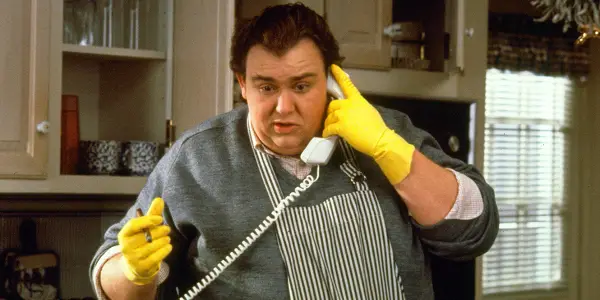
Uncle Buck stars John Candy as the irresponsible uncle of the title, who is called upon to look after his brother’s children – played by Macaulay Culkin, Gaby Hoffman and Jean Louisa Kelly. It saw Hughes continue his exploration of broader comedy, placing Candy in the forefront. Candy plays Buck as an overgrown man-child who shuns responsibility, but Hughes shows progression as a filmmaker by showing that this may not be the optimum lifestyle – a sign that his views on the subject had evolved from Planes, Trains and Automobiles.
Hughes retired from public life in the 1990s, largely due to Candy’s sudden death in 1994. Actor Vince Vaughn, a friend of the filmmaker, has said: “If Candy lived longer, I think John would have made more films as a director.” Yet Uncle Buck suggests a restlessness in Hughes, perhaps an indicator that his time as a director was coming to a close.
The film is unashamedly lightweight, mining the comedic chemistry between Candy and then nine-year-old Macaulay Culkin to great effect – it was watching the child actor that inspired Hughes to pen Home Alone, which propelled Culkin to household name status the following year. Hughes again demonstrated his ability to craft family films which form an enduring legacy – Uncle Buck is fondly remembered as one of Candy’s career-defining roles and the film has been subject to not one but two TV spin-offs.
In this film, Hughes also calls back to the teen angst that made his name through Jean Louisa King’s Tia, the eldest child who becomes embroiled in a battle of wits with her uncle. Hughes’ strength lay in his acute understanding of young people, which meant that his writing never talked down to them, but the Tia/Buck dynamic is one of the first times he appears to acknowledge the adult perspective.
Uncle Buck is a pleasant amalgamation of everything Hughes had done up to that point. A blend of broad comedy and teenage insight, the film towers as the best example of the great friendship Hughes and Candy shared.
Other work
Weird Science completes Hughes’ directorial teen trilogy, providing an excellent blend of comedy and sci-fi and featuring an early performance from Robert Downey, Jr.
Hughes became so synonymous with the teen genre that many films he wrote are also mistakenly believed by many to have been directed by him, with notable examples being Pretty in Pink and Some Kind Of Wonderful, both of which have his distinct stamp.
Home Alone and its sequel, Home Alone 2: Lost in New York, are two further screenwriting efforts from Hughes which proved to be among his most commercially successful works and again highlight his family appeal.
Anyone interested in exploring Hughes’ full range of writing work should look out for films written by Edmond Dantes, a pseudonym he used to avoid saturation/identification at certain points in his career.
Conclusion
Proof that a filmmaker does not have to be adorned in accolades to be treasured, John Hughes has helped generations of young people over the world face the difficulties of growing up. A pioneer of the modern teen film and arguably one of the most prolific mainstream filmmakers of the twentieth century, his work continues to capture the minds of young people, in spite of his untimely death in 2009 at age 59, and will continue to do so for generations to come.
What is your favorite John Hughes film? Why?
Does content like this matter to you?
Become a Member and support film journalism. Unlock access to all of Film Inquiry`s great articles. Join a community of like-minded readers who are passionate about cinema - get access to our private members Network, give back to independent filmmakers, and more.
Lauren is 20 years old and is a Multimedia Journalism student based in Glasgow, Scotland. She is originally from the Shetland Isles and has held a lifelong interest in film, which she documents on her blog apeerieyarn.wordpress.com. She loves Back to the Future and wishes people would stop paying to see Michael Bay movies.



